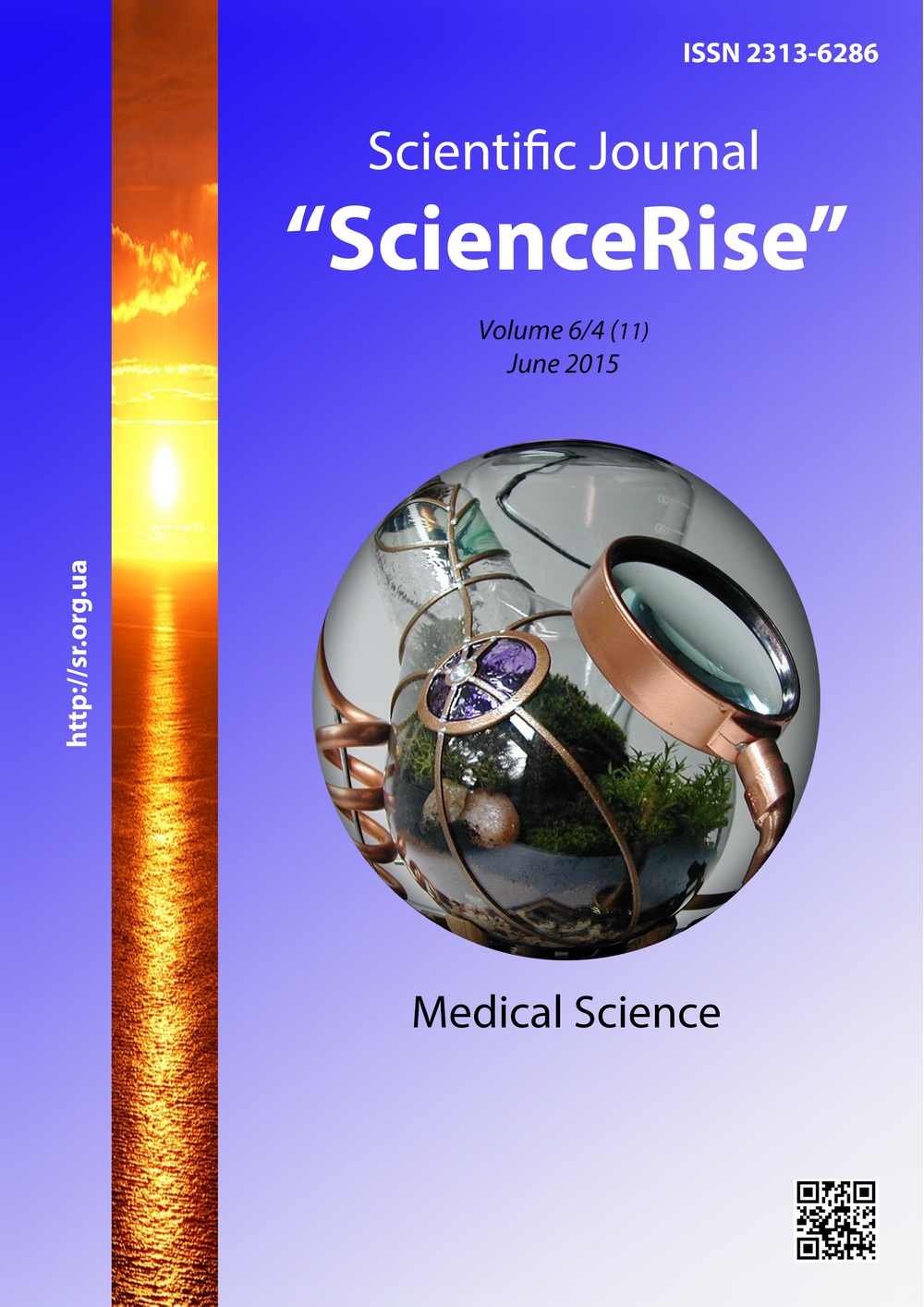An efficency of use phonophoresis with an ointment on the basis of chondroitin sulfate and dimetil sulfoxide at the treatment of patients with arthritis of knee joints
DOI:
https://doi.org/10.15587/2313-8416.2015.45282Keywords:
arthritis, knee joints, therapy, chondroitin sulfates, phonophoresisAbstract
Osteoarthritis is a frequent disease in people especially of the mean and elderly age.
Aim of research: the study of an efficiency of phonophoresis with an ointment on the basis of chondroitin sulfate and dimethyl sulfoxide at treatment of patients with osteoarthritis of knee joints in the outpatient setting.
Material and methods. Research was carried out by the clinical and laboratory examinations of 40 patients with osteoarthritis of knee joints in the outpatient setting. Patients were distributed between the main and control group depending on an approach to treatment. Indicators before and after treatment in all patients were assessed on 2 scales: the scale of assessment of knee joints (on J.N. Insall et al 1976) - (7 points) and 2) Oxford scale for knee joints (on W. Dawson et al, 1998) - (12 point). The level of oxyproline in daily urine was examined in all patients.
Results and discussions. The degree of manifestation of pain syndrome, movement amplitude and an everyday motor activity are the parameters of an efficiency of treatment.
Author noticed the more apparent efficiency of treatment in patients of the main group who underwent phonophoresis after rubbing an ointment on the basis of chondroitin sulfate in the region of injured knee joint.
Disappearance of pains after 10 PhPh with an ointment on the basis of chondroitin sulfate and dimethyl sulfoxide was noticed in 6 (30%) patients and diminution of pain intensity in 12 (60%) patients. So the general efficiency of treatment is 90% in the main group in relation to 70% of general efficiency of treatment without use this ointment in the control group.
Conclusions. 1. Phonophoresis with an ointment on the basis of chondroitin sulfate and dimethyl sulfoxide is a safe and rather effective method of treatment patients with osteoarthritis of knee joints of I-III radiographic stage, an efficiency of treatment is 90%.
2. The use of phonophoresis with an ointment containing combination of chondroitin sulfate and dimethyl sulfoxide in patients with osteoarthritis allows increase an efficiency of treatment by 20 % in comparison with standard scheme of physiotherapy in the control group.
3. Positive dynamics on the background of treatment was confirmed by the 2 international tests and laboratory examination of the level of oxyproline in daily urine and also by the more fast disappearance or decrease of pain syndrome and by increase of joints function in patients of the main group.
4. The use of phonophoresis with an ointment on the basis of chondroitin sulfates and dimethyl sulfoxide on injured knee joint is prescribed not only for inpatient treatment but also for an outpatient one at aftercare of residual effects especially in persons of an elderly age as a more available method that allows increase the quality of life in patients
References
Heike, A., Wieland, M., Bernhard, J. et. al. (2005). Osteoarthritis – an intreatable disease? Hature Publishing Groop, 4, 331–345.
Janis, K (2005). Chondroitin sulfate preserves joint-prace width in knee osteoarthrosis. Rheumawire – News, 5, 451–462.
Nasonov, E. L. (2001) Sovremennyie napravleniia farmakoterapii osteoartroza [The modern directions of osteoartrosis pharmacotherapy]. Consillium medicum, 3 (9), 81–87.
Pshetakovskii, I. L. (2004). Artrozy. Klinika, diahnostika, lecheniie i reabilitatsiia. [Artrosis. The clinic, diagnostic, treatment and rehabilitation]. Odessa: «Astroprint», 288.
Mort, J. S., Billington, C. J. (2001) Articular cartilage and changes in arthritis: Matrix degradation. Arthritis Res, 3, 337–341.
Alekseeva, L. I. (2003). Perspektivy khondroprotektornoi terapii osteoartrosa [The perspective of osteoartrosis hondroprotective therapy].Nauchno-practicheskaia revmatolohia, 5, 20–24.
Alekseeva, L. I. (2000) Sovremennyie predstavleniia o diagnostike i lechenii osteoartroza [The modern vision about diagnostic and treatment of osteoartrosis]. Russkii meditsinskii zhurnal, 2 (6), 1–20.
Nasonova, V. A., Nasonov, E. L. (2003). Ratsionalnaia farmakoterapiia revmaticheskikh zabolevanii [The rational pharmacotherapy of the rheumatic deseases]. Moscow: «Litera», 506.
Murphy, G., Knouper, V., Atkinson, S. et. al. (2002). Matrix metalloproteinases in arthritis disease. Arthritis Res, 4, 39–49.
Downloads
Published
Issue
Section
License
Copyright (c) 2015 Виктор Александрович Вишневский

This work is licensed under a Creative Commons Attribution 4.0 International License.
Our journal abides by the Creative Commons CC BY copyright rights and permissions for open access journals.
Authors, who are published in this journal, agree to the following conditions:
1. The authors reserve the right to authorship of the work and pass the first publication right of this work to the journal under the terms of a Creative Commons CC BY, which allows others to freely distribute the published research with the obligatory reference to the authors of the original work and the first publication of the work in this journal.
2. The authors have the right to conclude separate supplement agreements that relate to non-exclusive work distribution in the form in which it has been published by the journal (for example, to upload the work to the online storage of the journal or publish it as part of a monograph), provided that the reference to the first publication of the work in this journal is included.

